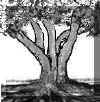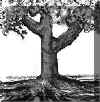| |
Poor
Branch attachment (V- Shaped Fork)

|
| Figure
1 |
Poor
branch attachment can be recognized as a sharp angle where
major branches join to the main trunk of the tree (Hickman,
et al., 1989) (Figure 1). If the angle where they join is
more like a narrow V than a U, then the union should be
examined for included bark. Included bark occurs where two
stems or main branches grow at such an acute angle that
the bark from both stems becomes imbedded making an extremely
weak branch union. When branches or co-dominant stems (two
or more stems growing at the same rate, from more or less
the same position) with included bark increase in size,
they may split from the trunk (Shigo, 1990). Poor branch
attachment also includes situations when a number of branches
are attached to the main stem at the same position. This
could occur as a result of pollarding, topping or a failure
to properly prune the tree when it was young. Epicormic
shoots following topping, pruning or storm damage have poor
attachment as well (Shigo, 1990).
Three classes for poor attachment
can be recognized:
| 0
|
Branches
properly attached, there are no signs of poor attachment |

|
| 1
|
A
V-shaped union between a minor branch and the main stem
(the diameter of the branch is 1/2 of the diameter,
or less, than the branch or main stem where it
is attached). There is no evidence of included bark,
but the angle of the fork is such that there is a potential
for this to appear as the tree grows. This category
also includes epicormic shoots following topping,
pruning or storm damage, etc. |

|
| 2
|
As
in 1, but the branch is more than 1/2 of the diameter
of the branch or main stem where it is attached, and
there is evidence of included bark but no breakage.
This category also includes trees with epicormic shoots
resulting from poor pruning or breakage, and multiple
trunks or co-dominant stems. Multiple stems are trunks
of equal size and/or relative importance arising from
the base of the tree, co-dominant stems are major branches
of similar diameter arising in the crown of the tree.
|

|
| 3
|
As
in 2, but with evidence of a crack between the stems.
|

|
Tree Problems Lean Lean
|
|
|
|